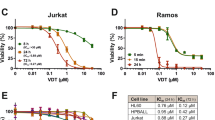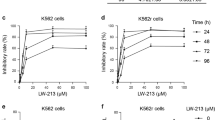Abstract
Leukemia is the disorder of hematopoietic cell development and is characterized by an uncoupling of cell proliferation and differentiation. There is a pressing need for the development of novel tactics for leukemia therapy as conventional treatments often have severe adverse side effects. Tryptanthrin (6,12-dihydro-6,12-dioxoindolo-(2,1-b)-quinazoline) is a naturally-occurring, weakly basic alkaloid isolated from the dried roots of medicinal indigo plants (Ban-Lan-Gen). It has been reported to have various biological and pharmacological activities, including anti-microbial, anti-inflammatory, immunomodulatory and anti-tumor effects. However, its modulatory effects and action mechanisms on myeloid cells remain poorly understood. In this study, tryptanthrin was shown to suppress the proliferation of the murine myeloid leukemia WEHI-3B JCS cells in a dose- and time-dependent manner. It also significantly reduced the growth of WEHI-3B JCS cells in vivo in syngeneic BALB/c mice. However, it exhibited no significant direct cytotoxicity on normal murine peritoneal macrophages. Flow cytometric analysis showed an obvious cell cycle arrest of the tryptanthrin-treated WEHI-3B JCS cells at the G0/G1 phase. The expression of cyclin D2, D3, Cdk 2, 4 and 6 genes in WEHI-3B JCS cells was found to be down-regulated at 24 h as measured by RT-PCR. Morphological and functional studies revealed that tryptanthrin could induce differentiation in WEHI-3B JCS cells, as shown by the increases in vacuolation, cellular granularity and NBT-reducing activity in tryptanthrin-treated cells. Collectively, our findings suggest that tryptanthrin might exert its anti-tumor effect on the murine myelomonocytic leukemia WEHI-3B JCS cells by causing cell cycle arrest and by triggering cell differentiation.
This is a preview of subscription content, access via your institution
Access options
Subscribe to this journal
Receive 12 digital issues and online access to articles
$119.00 per year
only $9.92 per issue
Buy this article
- Purchase on Springer Link
- Instant access to full article PDF
Prices may be subject to local taxes which are calculated during checkout
Similar content being viewed by others
Author information
Authors and Affiliations
Corresponding author
Rights and permissions
About this article
Cite this article
Chan, HL., Yip, HY., Mak, NK. et al. Modulatory Effects and Action Mechanisms of Tryptanthrin on Murine Myeloid Leukemia Cells. Cell Mol Immunol 6, 335–342 (2009). https://doi.org/10.1038/cmi.2009.44
Received:
Accepted:
Issue Date:
DOI: https://doi.org/10.1038/cmi.2009.44
Keywords
This article is cited by
-
Indigofera suffruticosa aerial parts extract induce G2/M arrest and ATR/CHK1 pathway in Jurkat cells
BMC Complementary Medicine and Therapies (2024)
-
Phytochemical and Pharmacological Properties of a Traditional Herb, Strobilanthes Cusia (Nees) Kuntze
Molecular Biotechnology (2023)
-
From natural dye to herbal medicine: a systematic review of chemical constituents, pharmacological effects and clinical applications of indigo naturalis
Chinese Medicine (2020)
-
Inhibiting eukaryotic ribosome biogenesis
BMC Biology (2019)
-
Indole trimers with antibacterial activity against Gram-positive organisms produced using combinatorial biocatalysis
AMB Express (2015)



